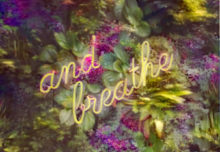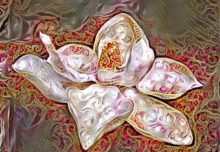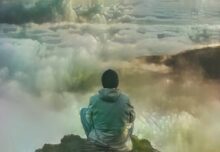
A Zen Master was chased by a tiger. He jumped over a cliff to escape and found himself hanging from a vine. He looked up and saw the tiger waiting patiently. He looked down and saw a second tiger waiting below. Two mice began gnawing through the vine. Just then the Zen Master saw a strawberry growing wild on the cliff. He picked it. How sweet it tastes!
The Sixth limb of Raja Yoga is called Dharana. Dharana is the practice of Concentration. Most minds lack Dharana to a greater or lesser degree and thus are scattered, agitated, distracted, foolish, dull, and/or stupid. Without the ability to concentrate and focus, nothing can be mastered.
Once Dharana has been learned, the mind becomes closely attentive and the mental faculties are focused upon a single point. Such a person has superior mental powers, and knows his desires. The ability to know one’s desire, and to marshal all aspects of body and mind in the pursuit of said desire can be dangerous. Such a person cuts through society like a hot knife through butter. There is a tendency to pursue the desired object without regard to the cost to others, and thus to generate great misery. This power can also serve to inflate the ego and thus lead the student off of the path of Raja Yoga. For this reason, Dharana is attempted only After the senses (and thus desires) have been brought under control through the practice of Pratyahara.
For a person who has mastered Dharana it is not enough to avoid the trap of pursuing Desires, for this still leaves them adrift in life without direction. The seventh limb of Raja Yoga, Dhyana (contemplation), provides that direction. Once Dharana has been mastered and the mind has been focused to a single point, that point is placed squarely and unwaveringly upon God.
How does one learn the practice of Dharana? There are many, many different techniques for mastering Dharana. In fact, Life ca
n be viewed as nothing more than an ongoing series of opportunities to practice Dharana. Washing dishes can be approached as an act of worship. Through the perfection of the washing of dishes you can experience Zen. Walking is a great opportunity for Dharana. Walk without destination… slowly, reverently, with great attention to walking. Eyes focused upon nothing; mind focused upon nothing. Driving a car is a wonderful opportunity to merge with the car, the traffic, the ebb and flow of life. The two most reliable techniques for achieving Dharana is concentration upon the symbol AUM, and upon the breath using the optional silent mantra of So-Han with each breath.
Two things destroy concentration… boredom and fear.
Fear is always a result of your goals being set too high in relation to your abilities. For example, if someone holds a gun to your head and you experience fear, it is a direct result of your goals being set to high. You want to live, and this is no longer within your ability to control, and so you experience fear. If you can let go of the goal to live, and choose a new goal, in keeping with your abilities in the present situation you can again achieve focus. Perhaps your new goal could be to understand the person holding the gun. What is interesting is that once you choose an appropriate goal and regain your powers of concentration, you are able to maneuver more skillfully and outcomes improve.
Boredom is always the result of setting your goals too low with respect to your abilities. Choose goals that challenge without intimidating and you will live a life with more flow, more concentration and less boredom and fear.
The state of deep concentration – Dharana – is what we all are looking for in our lives. At work, on dates, in our hobbies, we are all trying to avoid boredom and fear, we are all seeking flow or peak performance, or what we call in Yoga… Dharana.
The story I opened this lecture with has grown to be one of my favorites. While camping on the Olympic Peninsula in late October I took a hike up into the virgin-rain forest covered mountains. I set off cross country and alone, with a hand drawn map and a heavy coat looking for an adventure. After several hours I found the creek that drained from ‘Mink Lake’ and set off to follow it up stream to the lake. This plan was soon abandoned as I faced a series of vertical waterfalls that spilled over 20–60-foot sheer walls. Now I started cutting up the side of the valley keeping the stream to my left. I climbed higher and higher and the terrain became more and more impassable. I drove myself relentlessly through the rain.
By three o’clock I decided to cut straight up the side of the mountain, the shortest route to the hike trail. The slopes ranged from 70` to 90` in places and I found myself climbing now. Still no trail. By four o’clock, the very real possibility of spending the night on the mountain encouraged me to abandon my search for the path. I started cutting diagonally down the side of the mountain towards the campsite. At one point I saw a lake far, far beneath me and I redoubled my descent, thinking I had somehow stumbled onto ‘Mink Lake’, but as I at last drew near, the lake dissolved into clouds and I found myself descending through heavy fog.
Time and again I found myself trapped by cliffs dropping away on three sides, and was forced to backtrack up and over, only to come to the top of another dizzying drop. As daylight faded, I was overcome by waves of panic… I did not think I could find a way down the mountain before the dark set in, and my chances of surviving in my present condition through the night did not rate favorably. This resulted in my taking chances over and over again, and I could feel my luck running out.
When I found myself on level ground for the first time in hours, I broke into a run to try and make up for lost time – pushing through heavy, rain-soaked foliage. In a matter of minutes, the bushes had done what 7 hours of rain had not. My coat was water logged and I was wet. I knew that I was losing energy due to dropping temperatures, lack of food, water and the most strenuous challenge of my entire life.
It was at this point that I noticed that the bushes were wild blueberry bushes, and that they were covered with ripe berries. I remembered the story of the Zen master and followed his example, eating berries, drinking water from the leaves and laughing at and to myself as the daylight drained from the sky. Renewed, refreshed, and calm, I set off again, more slowly and in the dark, felt with my feet, the faint difference in texture that betrayed a path. Had I been moving quickly, I would have crossed the path without noticing it, and plunged on into the night. As it was, I found the path and followed it back to my camp site, where I soaked in hot springs while rain fell softly and mist drifted between the trunks of old growth trees.





